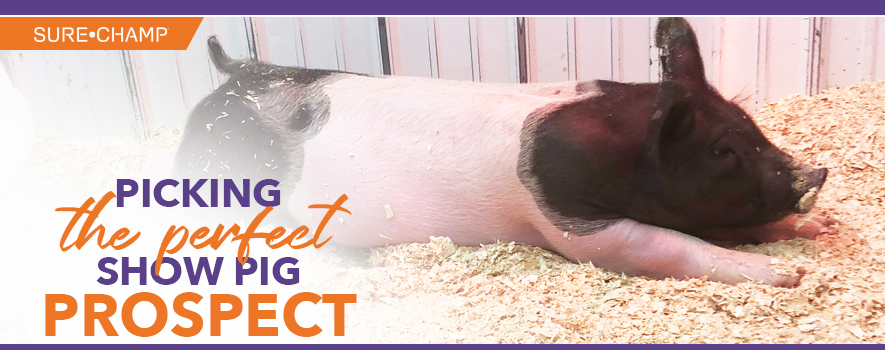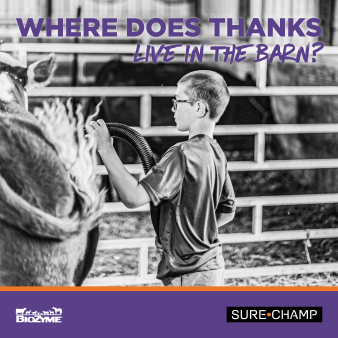
There is something very exciting about picking out your next set of show animals. If you’re looking for just the right show pig prospects for the World Pork Expo or CPS Summer Type Conference, you’ve probably already had your fair share of disposable plastic booties on checking out pigs on various farms or watching online sales every night. If your county and state fair is later in the summer, you’re probably still looking for the ideal prospect that will help you find your way to the winner’s circle.
Recently, Blaine Rodgers, Show Livestock Business Development at BioZyme® Inc., shared his thoughts on selecting the ideal market hog prospect. Not only does Rodgers work in the show animal nutrition industry, but his daughter, Payton, also showed the Grand Champion Market Hog at the 2018 National Western Stock Show.
“The first thing I always tell everyone is they need to understand what their goal is and understand when that desired endpoint is, because going and looking for the best one doesn’t mean they are the best one for your show,” Rodgers said. “Understanding when they need to show and what the pig needs to look like from an age and maturity pattern and working with that breeder is important. Communicate with the seller because he or she will understand the pig’s genetics and how that will influence its endpoint. The biggest mistake people make is trying to find the best one, and the best one at a sale might not be the best for your endpoint.”
Once you have determined your prospective endpoint and communicated that to the seller, that will give the seller a better idea of exactly what kind of pig you are looking for. Genetic make-up and feeding programs heavily influence the muscle development and growth of show pigs, and according to Rodgers picking the heaviest muscled one early on isn’t always the best selection criteria.
“My upmost criteria are build and skeletal design. That’s the first priority I take into consideration,” he said.
Young pigs need to be square in their build. It all starts at their foundation. The size and shape of their foot and how they distribute their weight impacts how they handle their hock and front knee. Likewise, the width of their chest and base width going away needs to match. This will allow you to better predict the way they will come with muscle. Even a baby pig that’s skinny and looks like they are light muscled can get stout and wide if they are square underneath and read with some feature in their head and bone work.
“I don’t think it matters what species you’re talking about, if their skeletal design is correct, everything else should follow,” Rodgers said.
Although Rodgers places the most emphasis on skeletal shape and structure, he said that muscle shape is important. However, he realizes that a lot of that muscle development comes through good nutrition and genetics.
“They have to have some indication of muscle shape; chest width, rib shape and pin width when you study them from behind. Back shape and muscle shape is hard to read, and not as important. Every pig we ever won with started as a skinny one,” he said.
You have selected and purchased your show pig project and brought them into your barn. Now, it is time to start working on the nutrition management portion of your project. As Rodgers indicated, muscle development is heavily dependent on nutrition. And to get them started right, you want to keep them eating and drinking every day. Once you get your show pigs home, introduce them to Vita Charge® Liquid Boost® in their water. Liquid Boost supports digestive health and promotes feed and water intake during times of stress and recovery. It contains Amaferm®, is a prebiotic designed to enhance digestibility by amplifying the nutrient supply for maximum performance. It is research-proven to increase intake, digestion and absorption.
Another way to make sure your pigs get the Amaferm advantage every day is to add Sure Champ® Spark to their diet. Sure Champ Spark is a pelleted supplement that continues to drive the appetite. Both the Sure Champ and Vita Charge Liquid Boost also contain MOS to trap bad bacteria, limiting their ability to do harm to the gut.
And, when temperatures start to warm up this summer, Sure Champ has created Sure Champ Extreme with Climate Control. It also contains Amaferm and MOS, but has a unique ingredient to help maintain circulation to support animal performance in extreme temperatures.
“Feeding any livestock in the heat of summer is definitely a bigger challenge than say the spring or fall of the year. That is when we recommend Extreme. That way you’ll be giving your animals Sure Champ every day. And that will help them drive their appetites every day,” Rodgers said.
A goal. An endpoint. It’s hard to picture a little pig becoming a nearly 300-pound champion, but when you are in those chip barns looking for your perfect pig prospect, remember to think about what you want them to look like 120-150 days from now. And to help you #preptowin, make sure they get Sure Champ. Every. Day.

